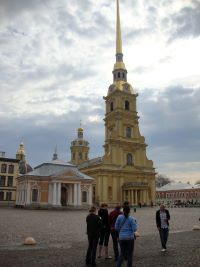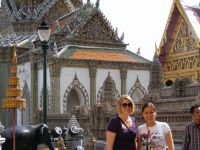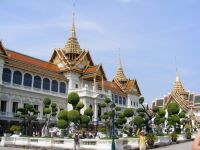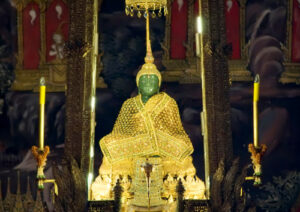It occurred to me today that Bangkok, at least for the tourist, and based on our two fully-filled days, is a tribute to two rulers—the Lord Buddha in a religious sense, and the Lord Rama (the ruling dynasty) in a political sense. They’re related. The Chakri family has supplied the kings since the foundation of Bangkok in 1782. Rama IX, who has been the king for over 60 years, is the longest reigning monarch in the world.
While the kings were absolute rulers (even despots—see the thinly historical King and I) until 1932, King Bhumibol (his non-reign name) and his wife have earned a great deal of respect from the Thai people. Our guide proudly refers to him as “our king,” and the pictures are ubiquitous. At various times, he has called the military rulers into the palace and ordered them to grovel, thereby saving the constitutional monarchy.
He and his family certainly enjoy the trappings of royalty, as we’ve seen the past two days, having visited the summer palace yesterday, the Grand Palace today, and various and sundry palaces today. The current palaces were heavily influenced by Chulalongkorn, otherwise known as Rama V, who was one of the children in the King and I, where Yul Brynner, as Rama IV, King Mongkut, fell under the spell of Anna, and his son brought lots of Western influences into the then Kingdom of Siam. Under Mongkut, the Thais built a summer palace that for all the world looked like Versailles; it’s very European. The Grand Palace, similarly, has some very European 
 buildings, but with the Thai roofs (which I learned today have a triangular shaped roof with the Garuda at the top—a bird-like figure who was the carrier of Lord Shiva [look up your Hindu/Buddhist gods]—and the Naga, a snake, at the corners of the triangle), making the appearance definitely Thai-European. We were in the palace this morning, and, ala London, there was a changing of the guard—spiffy uniforms, white pith helmets, not so spiffy drill. We were told the soldiers had no bullets,
buildings, but with the Thai roofs (which I learned today have a triangular shaped roof with the Garuda at the top—a bird-like figure who was the carrier of Lord Shiva [look up your Hindu/Buddhist gods]—and the Naga, a snake, at the corners of the triangle), making the appearance definitely Thai-European. We were in the palace this morning, and, ala London, there was a changing of the guard—spiffy uniforms, white pith helmets, not so spiffy drill. We were told the soldiers had no bullets,  very unlike London, but then the royal family no longer lives in the Grand Palace, which is used only to house dignitaries, and possibly impress tourists, which it certainly does. The other palaces we saw were interesting, too, but less grand—a summer house made of golden teak that had been moved from elsewhere in the country to Bangkok, and still had the marks from a bomb that had been dropped on it in World War II (when, interestingly, Thailand sided with the Japanese and declared war on the United States)—it had a lot of windows, which indicated before air conditioning there was only one way to cool off, and that was to depend on breezes, or what was known as a pukka walla, a contraption which allowed a servant to foot-pump a fan. The final “palace” we saw had been the home of one of the sons of Chulalongkorn; he was an avid collector of a variety of things—including some sculptures that had once been at Angkor Wat—whose family had various homes from around the country brought to Bangkok to house his collection. The prince himself had been sent into exile in 1932; when the generals ended the absolute monarchy, the prince, as the head of the absolute monarch’s state council, was invited to leave, and lived his life in Indonesia.
very unlike London, but then the royal family no longer lives in the Grand Palace, which is used only to house dignitaries, and possibly impress tourists, which it certainly does. The other palaces we saw were interesting, too, but less grand—a summer house made of golden teak that had been moved from elsewhere in the country to Bangkok, and still had the marks from a bomb that had been dropped on it in World War II (when, interestingly, Thailand sided with the Japanese and declared war on the United States)—it had a lot of windows, which indicated before air conditioning there was only one way to cool off, and that was to depend on breezes, or what was known as a pukka walla, a contraption which allowed a servant to foot-pump a fan. The final “palace” we saw had been the home of one of the sons of Chulalongkorn; he was an avid collector of a variety of things—including some sculptures that had once been at Angkor Wat—whose family had various homes from around the country brought to Bangkok to house his collection. The prince himself had been sent into exile in 1932; when the generals ended the absolute monarchy, the prince, as the head of the absolute monarch’s state council, was invited to leave, and lived his life in Indonesia.
The Lord Buddha received his due today from us as well. There are reputedly over 650 Wats (Buddhist temples) in Thailand, a religion the Thais share with the approximately 5 million Chinese in Bangkok—who control much of the larger businesses (as our guide remarked, they’ve been in the country for years, and they’re hard-working; we’re not). The Wat we visited was one  of the Royal Temples. It’s in the grounds of the grand palace, and houses the Emerald Buddha, one of the most important relics of the faith in Thailand. The whole complex houses statuary that are the typical “guardians” of the Buddhist temples, but with the colorful cut glass and precious stones and the faces that are typical Thai. It’s a stunning display that still impresses me after years of coming here.
of the Royal Temples. It’s in the grounds of the grand palace, and houses the Emerald Buddha, one of the most important relics of the faith in Thailand. The whole complex houses statuary that are the typical “guardians” of the Buddhist temples, but with the colorful cut glass and precious stones and the faces that are typical Thai. It’s a stunning display that still impresses me after years of coming here.
Finally, we’ve spent more time on the Chao Phraya, which is the “River of Kings.” We came back from Ayudhya by boat yesterday, and had a dinner cruise tonight on the river, that took us past the palaces—and the newer palaces for the rich, like the Mandarin Oriental hotel, usually ranked as one of the top five hotels in the world. The buffet, thanks to our guide, included Pad Thai, one of the most popular and famous of the Thai dishes.
Tomorrow we get on the train for Butterworth Malaysia at 2:49, an overnight train ride.
The adventure continues!